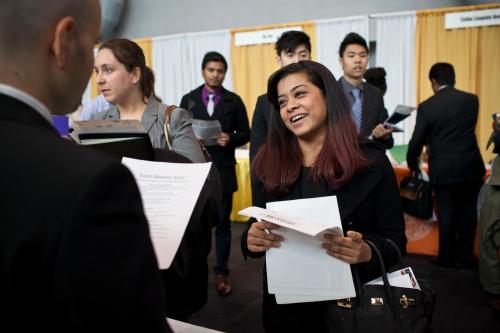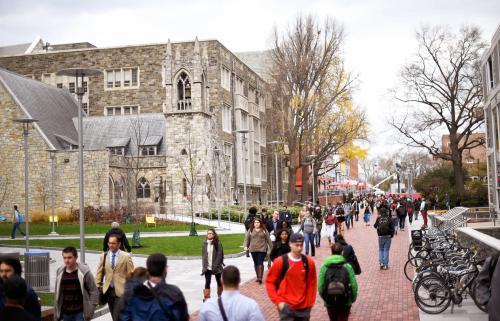Is college worth it? The public is increasingly skeptical. A Wall Street Journal/NORC poll this year found 56% of adults said a four-year college was “not worth the cost,” up from 40% in 2013. This perception is perhaps unsurprising given rising media and political attention to the negative consequences of student loan debt. The labor force is also relatively strong, even for workers with no college experience, making it costlier to pause or defer employment. Political discourse around college (and education broadly) has also become more partisan, with Republicans becoming increasingly skeptical around the value of college.
However, on average, college completion still pays off. College graduates earn more, experience lower unemployment, pay more in taxes, and are less likely to engage in criminal behavior. College graduates overwhelmingly believe college was a good personal investment. Despite these benefits, college enrollment has declined for years, with more dramatic drops since the onset of the COVID-19 pandemic. This post examines the root causes of declining enrollment and what policies can effectively encourage college enrollment.
College enrollment declines have accelerated since pandemic
Insights from the National Student Clearinghouse paint a grim picture. Overall enrollment is down, especially at community colleges. Undergraduate completion fell for the first time in ten years. There are more “stopped out” students—students who left college with some credits but no degree. Fewer students are transferring from two-year to four-year institutions.
The biggest declines happened in fall 2020 as first-time enrollment decreased about 10% and overall enrollment fell 2.5% and have since slowed. However, even prior to the pandemic, enrollment was declining. From 2010 to 2021, undergraduate enrollment dropped by 15%, translating into about 2.6 million fewer students. About 58% of that decline occurred over the decade prior to the pandemic, with about 42% of the total enrollment decline occurring between fall 2019 and fall 2021. In the shorter-term, from fall 2017 to fall 2019, 41 states experienced a decline in undergraduate enrollment and only six states had a meaningful increase (more than 2%).
Interestingly, state-level post-pandemic enrollment shifts align with pre-pandemic enrollment trends, as shown in Figure 1. States with pre-pandemic enrollment growth (dark blue) have had had relatively steady enrollment since the pandemic started. In states with large (more than a 5%) declines pre-pandemic, enrollment declined on average by 7.9% from fall 2019 to fall 2022 (dark orange). Enrollment recovery efforts must focus not only on pandemic-induced education shifts but also on these longer-term trends and state-specific patterns.
Variation in college enrollment trends
At the individual level, some students may eschew college for promising labor market opportunities. But we would be particularly concerned as a society if the short-term costs of college, inequities in college preparation, or the perception that college is not a good fit resulted in racial, socioeconomic, or gender differences in college enrollment that then affected the diversity and economic wellbeing of the workforce.
The recent National Center for Education Statistics Condition of Education highlights concerning gaps in college enrollment by sex. In fall 2021, 70% of female high school graduates immediately enrolled in college, compared to 55% of male students. This is a marked increase in the college enrollment gap by sex that erased any gains in parity over the past decade. Research by Brookings colleagues shows there are already large gaps in high school graduation rates by sex overall and within race, with the recent NCES data showing those gaps in educational attainment only widen further after high school.
Understanding which students were most impacted by enrollment declines is the first step to engaging in targeted recovery efforts. Figure 2 examines undergraduate enrollment changes by race, ethnicity, immigration status, and gender. In the blue bars, I show the percent change between fall 2017 and fall 2019, and in the orange bars I show the percent change between fall 2019 and fall 2021.
Pre-pandemic, enrollment grew among Asian and Hispanic men and women as well as those indicating two or more races but declined for other groups. Fall 2021 enrollment was below fall 2019 for nearly every group. Declines were less steep for women, with fall 2021 enrollment down 4.9%, compared to an 8.2% decline for men. This pattern holds within each race but varies in magnitude. The largest gaps are between American Indian/Native and Native Hawaiian/Pacific Islander men and women—for example, almost the same number of Native Hawaiian/Pacific Islander women enrolled in college in fall 2021 compared to fall 2019, but for men enrollment declined 11.5%. The largest pandemic-era enrollment declines were for nonresident alien men (18.6%) and women (15.5%), with much of those declines likely attributable to COVID-era global migration policies and preferences.
College enrollment efforts must go beyond high schoolers
Part of the longer-term decline in initial college enrollment is due to declines in the youth population. Successful efforts to improve post-high school college access include expanding early college and career technical education as well as investments in financial aid, but bolstering overall college enrollment numbers will require thinking beyond recent high school graduates.
One potential pool of new enrollees is adult workers who haven’t previously attempted college. Older enrollees often start their postsecondary education in noncredit programs or short-term credentials. There can be variation in the labor market returns to those credentials, but workers who use these programs as a launchpad for stacking credentials—or those completing programs with close partnerships with the local labor market—can experience significant wage benefits.
Another group of potential college enrollees is students who have attempted some college but have not earned a credential. As of July 2021, 40.4 million individuals had “stopped out” of postsecondary education. Many of those students have accumulated a substantial number of credits. For example, one third have completed at least three quarters of their degree requirements. Re-enrollment rates are low —9% of recent stop-outs re-enrolled for the 2021-22 academic year. Persistence a year after re-enrollment varies substantially by school type, from 71% of students who re-enroll at four-year institutions to 57% of re-enrollers at community colleges.
Cost remains key barrier—and solution—to enrollment
The annual State of Higher Education report from Gallup and the Lumina Foundation found that 47% of adults who aren’t currently in college, including 61% of stopped-out students, have thought about enrolling in the past few years. What drives the college enrollment intention-action gap? The top reported barriers to enrollment related to cost—whether that was 55% of prospective students citing cost of the program, 45% mentioning inflation, or 38% noting the need to work and the opportunity cost of enrolling.
While many financial aid programs target traditionally aged enrollees, there have been more state aid programs targeting older enrollees and re-enrollment, such as the Tennessee Reconnect promise scholarship.
Pandemic-induced unemployment prompted states to make temporary adjustments to eligibility criteria for financial aid programs targeting older workers, such as waiving requirements to be first-time students or waiving requirements for individuals that have not previously earned a postsecondary credential. States should incorporate those waivers into their permanent aid programs. Further, while many “reconnect” programs target individuals who are 24 or older with a focus on career development, lowering the age of eligibility (as Michigan recently did) could expand aid to the large share of 20 to 24-year-olds who didn’t start college (particularly those who would have enrolled in community colleges) during the pandemic.
Expanding financial aid is an important first step. However, older workers also do not benefit from access to high school counselors and other efforts to support financial aid access. States and colleges must engage in informational efforts to raise awareness of financial aid programs, which likely involves partnerships with local employers and other state benefits systems, such as unemployment insurance offices. And direct costs are not the only barriers to enrollment. For example, the Gallup/Lumina poll found currently unenrolled Black and Hispanic adults were more interested in going back to school than white counterparts but were more likely to identify mental health or childcare/kinship care responsibilities as barriers to enrollment—more investments are needed to address these concerns and to build a student support system that works for all students.
States need to continue promoting and supporting college enrollment, even as they work to reform higher education. For example, there are real concerns with the structure of U.S. student loans and particularly racial inequities in debt. Students also need clearer guidance on the value of a given program before they enroll. However, there must be a balance between giving serious policy attention to reforming higher education while simultaneously emphasizing that for most students, a postsecondary credential pays off. Individuals and society benefit from college enrollment and completion, and recovery from pandemic-induced enrollment drops should continue to be a core policy focus for states and federal actors in the years to come.
The Brookings Institution is committed to quality, independence, and impact.
We are supported by a diverse array of funders. In line with our values and policies, each Brookings publication represents the sole views of its author(s).









Commentary
The case for college: Promising solutions to reverse college enrollment declines
June 5, 2023